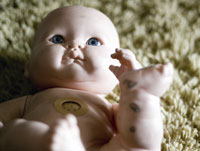
Social workers are effectively being pressurised to ignore child abuse as a result of budget cuts, an exclusive Community Care survey has revealed.
The poll of 170 frontline workers found that 58% believed pressure had been placed on them to reclassify child protection cases as less serious child-in-need cases.
More than four-fifths of respondents felt child protection thresholds had increased in their area over the past year.
Half had experienced increased thresholds in cases of neglect, 44% in emotional abuse cases, 24% in physical abuse cases and 15% in sexual abuse cases.
Budget cuts, increases in child protection referrals and a lack of social workers were given as the main reasons for the rise in child protection thresholds.
Children involved in domestic violence cases were said to be missing out on support. One social worker said a four-year-old child was at significant risk of physical and emotional abuse due to witnessing ongoing domestic violence. “There was pressure not to recommend a child protection plan in my initial child protection conference report and to vote against a child protection plan at the conference,” they said.
Almost two-thirds of those who had experienced pressure to reclassify cases described themselves as scared about the risks they carried in taking the decision; 84% of them said reclassifications were typically against children’s best interests.
Special report on Community Care’s child protection threshold survey
In addition, more than 40% reported having additional pressure placed on them to return children in care back to their birth families, with most of them feeling this was done only to save money and reduce the number of children in care.
Sixty per cent said children on care orders were being removed from child protection plans, even when they remained at risk.
One respondent gave an example of a child with an unexplained injury who was removed from a protection plan following the granting of an interim care order, “even though the child remained living with parents, who were thought to have been responsible for the injury”.
Another said the local safeguarding children board had instructed that any child accommodated in care would be ineligible for a child protection plan “because they do not want to run a dual process”.
Many claimed teenagers were falling off the child protection agenda. One wrote: “Child protection plans seem to be for the younger children.”
Another social worker said the most pressure to return or keep children with birth families came when children were over the age of 15: “I’ve often heard the argument ‘well they’ve managed to survive this long’.”
What do you think? Join the debate on CareSpace
Keep up to date with the latest developments in social care. Sign up to our daily and weekly emails
Related articles
Child protection alarm – in social workers’ own words
Social workers ‘must blow the whistle’
Child protection thresholds too high to target sexual abuse
Special two-part report on child protection thresholds and risk management
8,000 vulnerable children denied social workers
Inform subscribers
Guide to risk assessment of child neglect
Interviewing children for the purposes of child protection investigations


 Bournemouth, Christchurch and Poole
Bournemouth, Christchurch and Poole  Hampshire County Council
Hampshire County Council  Lincolnshire County Council
Lincolnshire County Council  Norfolk County Council
Norfolk County Council  Northamptonshire Children’s Trust
Northamptonshire Children’s Trust  South Gloucestershire Council
South Gloucestershire Council  Wiltshire Council
Wiltshire Council  Wokingham Borough Council
Wokingham Borough Council  Children and young people with SEND are ‘valued and prioritised’ in Wiltshire, find inspectors
Children and young people with SEND are ‘valued and prioritised’ in Wiltshire, find inspectors  How specialist refugee teams benefit young people and social workers
How specialist refugee teams benefit young people and social workers  Podcast: returning to social work after becoming a first-time parent
Podcast: returning to social work after becoming a first-time parent  Podcast: would you work for an inadequate-rated service?
Podcast: would you work for an inadequate-rated service?  Family help: one local authority’s experience of the model
Family help: one local authority’s experience of the model  Workforce Insights – showcasing a selection of the sector’s top recruiters
Workforce Insights – showcasing a selection of the sector’s top recruiters 

 Facebook
Facebook X
X LinkedIn
LinkedIn Instagram
Instagram
Comments are closed.